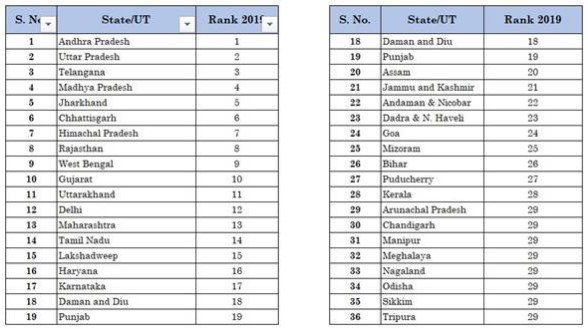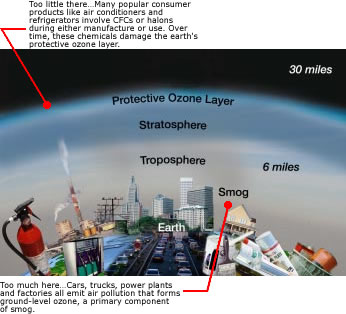Contents
- Business Reform Action Plan 2019 Ranking
- Start-Up Village Entrepreneurship Programme (SVEP)
- G20 Education Ministers Meeting
- Low ozone over Brahmaputra River Valley
BUSINESS REFORM ACTION PLAN 2019 RANKING
Focus: GS-III Indian Economy
Why in news?
- Union Minister of Finance and Corporate Affairs announced the 4th edition of Business Reform Action Plan (BRAP) ranking of states.
- State rankings will help attract investments, foster healthy competition and increase Ease of Doing Business in each State.
- Ranking of States is based on the implementation of Business Reform Action Plan started in the year 2015.
Highlights of how the states fared:
The top ten states under State Reform Action Plan 2019 are:
- Andhra Pradesh
- Uttar Pradesh
- Telangana
- Madhya Pradesh
- Jharkhand
- Chhattisgarh
- Himachal Pradesh
- Rajasthan
- West Bengal
- Gujarat

Business Reform Action Plan (BRAP) – 2018 – 19
- The Business Reform Action Plan (BRAP) is aimed at promoting competition among states with a view to improving the business climate to attract domestic as well as foreign investments.
- The BRAP includes recommendations for reforms on regulatory processes across various reform areas such as labour regulation enablers; contract enforcement; registering property; inspection reform enablers; single window system etc.
- The BRAP Plan 2018-19 includes 180 reform points covering 12 business regulatory areas such as Access to Information, Single Window System, Labour, Environment, etc.
- The larger objective of attracting investments and increasing Ease of Doing Business in each State was sought to be achieved by introducing an element of healthy competition through a system of ranking states based on their performance in the implementation of Business Reform Action Plan.
- The Ease of Doing Business Index is based on the BRAP.
Ease of Doing Business Index
- Ease of Doing Business report is an Annual Report published by the World Bank which ranks countries based on their performance in easing the rules and regulations to start a business. “Ease of doing business” refers to the regulatory environment in a country to set up and operate a business.
- Economies are ranked on their ease of doing business, from 1–190. A high ease of doing business ranking means the regulatory environment is more conducive to the starting and operation of a local firm.
Criteria
A nation’s ranking on the index is based on the average of 10 sub-indices:
- Starting a business – Procedures, time, cost and minimum capital to open a new business
- Dealing with construction permits – Procedures, time and cost to build a warehouse
- Getting electricity – procedures, time and cost required for a business to obtain a permanent electricity connection for a newly constructed warehouse
- Registering property – Procedures, time and cost to register commercial real estate
- Getting credit – Strength of legal rights index, depth of credit information index
- Protecting investors – Indices on the extent of disclosure, extent of director liability and ease of shareholder suits
- Paying taxes – Number of taxes paid, hours per year spent preparing tax returns and total tax payable as share of gross profit
- Trading across borders – Number of documents, cost and time necessary to export and import
- Enforcing contracts – Procedures, time and cost to enforce a debt contract
- Resolving insolvency – The time, cost and recovery rate (%) under bankruptcy proceeding
Highlights of India’s ranking
- India climbed 14 ranks in the World Bank’s Ease of Doing Business 2020 survey to stand at 63, among 190 countries, making it the one of world’s top 10 most improved countries for the third consecutive time.
- Compared with 2019, in 2020 India’s ranking deteriorated on only two parameters — “protecting minority investors” (from 7th to 13th position) and “getting electricity” (from 22nd to 25th) — and remained unchanged in “enforcing contracts”.
- Among the BRICS countries only Russia and China are ahead of India with their rankings at 28 and 31 respectively.
- Among the SAARC countries India is the topper in rankings.
START-UP VILLAGE ENTREPRENEURSHIP PROGRAMME (SVEP)
Focus: GS-III Indian Economy
Why in news?
Start-Up Village Entrepreneurship Programme (SVEP) has extended business support services and capital infusion to 23 states, and as of August 2020, around 1 lakh enterprises are being supported out of which 75% are owned and managed by women.
Start Up Village Entrepreneurship Programme (SVEP)
- The Start-up Village Entrepreneurship Program is a sub component of Deendayal Antyodaya Yojana – National Rural Livelihoods Mission (DAY-NRLM) of the Ministry of Rural Development, as a sub-scheme since 2016.
- With an objective to support the rural poor come out of poverty, supporting them setup enterprises and provide support till the enterprises stabilize, SVEP focusses on providing self-employment opportunities with financial assistance and training in business management and soft skills while creating local community cadres for promotion of enterprises.
- SVEP promotes both individual and group enterprises, set-up and promote enterprises majorly on manufacturing, trading and service sectors.
- Any Rural poor who is willing to be entrepreneurial and self-reliant is eligible to be part of this programme.
- Highly vulnerable beneficiaries under MGNREGA, marginalized sections, women, SC and ST communities and rural artisans will be given specific preference in selection, as part of this programme.
More about SVEP
- SVEP addresses three major pillars of rural start-ups namely – finances, incubation and skill ecosystems.
- Activities under SVEP are strategically designed to promote rural enterprises, one of the key areas is to develop pool of community resource persons – enterprise promotion (CRP-EP) who are local and support entrepreneurs setting-up rural enterprises.
- Another key area is to promote the block resource centre (BRC) in SVEP blocks, to monitor and manage the community resource persons, appraise SVEP loan application and acts as the repository of enterprise related information in the concern block.
- BRCs play the role to support sustainable revenue model to operate effectively and independently.
The key objectives of SVEP are:
- To enable rural poor to set up their enterprises, in its proof of concept phase, by developing a sustainable model for Village Entrepreneurship promotion through integrated ICT techniques and tools for training and capacity building, enterprise advisory services and to provide loans from banks/SHG & federations.
- Develop local resources by training a pool of village level community cadre (CRP EP) and build the capacity of the NRLM and SHG federations to monitor and direct the work of the CRP-EPs.
- Help the rural entrepreneurs to access finance for starting their enterprises from the NRLM SHG and federations, the banking systems including the proposed MUDRA bank.
- Handhold the rural entrepreneurs/ enterprises in the initial six months of start-up, with visits from the CRP-EP’s supported by guidance from an advisory panel of experts for the relevant enterprise.
Deendayal Antyodaya Yojana –National Rural Livelihoods Mission (DAY-NRLM)
- National Rural Livelihood Mission (NRLM) is a poverty alleviation project implemented by Ministry of Rural Development, Government of India.
- This scheme is focused on promoting self-employment and organization of rural poor.
- The basic idea behind this programme is to organize the poor into SHG (Self Help Groups) groups and make them capable for self-employment.
- Deendayal Antyodaya Yojana – National Rural Livelihood Mission (DAY-NRLM) is a new name given to Aajeevika – NRLM in November 2015.
- The initiative to move towards a demand-driven strategy enabling the states to formulate their own livelihoods-based poverty reduction action plan is at the core of the mission.
- The strength of Deendayal Antyodaya Yojana-National Rural Livelihoods Mission (DAY-NRLM), Ministry of Rural Development, are the approximately 690 lakh women members of around 63 lakh Self Help Groups (SHGs) across the country.
G20 EDUCATION MINISTERS MEETING
Focus: GS-II International Relations
Why in news?
A virtual meeting of G20 Education Ministers was held to discuss and share experiences of member countries in the three identified areas of Education Continuity in Times of Crises, Early Childhood Education and Internationalization in Education.
Highlights
- Regarding ensuring education continuity in times of crises, the communique recognizes the value of distance and blended teaching and learning and underscore the importance of enhancing access to high-quality education, professional development for educators, digital infrastructure and content, cybersecurity awareness, appropriate teaching methodologies and active learning, while recognizing that these approaches complement face-to-face learning.
- On the importance of Early Childhood Education (ECE) the communique emphasizes the importance of improving the accessibility and affordability of quality ECE for all children, especially those in vulnerable groups.
- It also stresses on the need to raise family and community awareness of the vital role of quality ECE that is delivered in accordance with children’s developmental needs at each stage.
- The communique expresses the resolve to encourage internationalization in education by sharing of best practices in education and the adaptation of such practices at the local, national, and international levels, as appropriate.
- It also supports advancing the discussion on internationalization at the K-12 level.
Click Here to read more about the G-20 Group
LOW OZONE OVER BRAHMAPUTRA RIVER VALLEY
Focus: GS-III Environment and Ecology
Why in news?
Researchers have found that the concentration of near surface ozone in this region in the North-East corner of India is low compared to the other urban locations in India.
Details
- Scientists have evaluated the near surface ozone in the Brahmaputra River Valley (BRV) and found relatively low concentration of Ozone over Guwahati compared to the other urban locations in India.
- The examination of nitric oxide, nitrogen dioxide, and ozone concentrations in this study suggested that this site is well influenced by local sources such as adjacent major national highway.
Ozone: Good at Stratosphere, Bad on ground
What is ozone?
- Ozone is a gas that occurs both in the Earth’s upper atmosphere and at ground level.
- Ozone occurs in two layers of the atmosphere – Troposphere (Layer Closest to Earth’s Surface) and Stratosphere (layer that extends from 10 to 50 kilometres).
- About 90% of Earth’s ozone is found in the Stratosphere.
How Can Ozone Be Both Good and Bad?
- The ozone in the stratosphere forms the ozone layer, which shields everything on the planet’s surface from the sun’s harmful ultraviolet rays.
- Ground-level or “bad” ozone is formed at the surface (when chemical reactions occur between oxides of nitrogen (NOx) and volatile organic compounds (VOC) with UV rays), and it is a pollutant itself as it can damage forests, crops and can irritate human lungs.
- Emissions from industrial facilities and electric utilities, motor vehicle exhaust, gasoline vapors, and chemical solvents are some of the major sources of NOx and VOC.

- Occasionally, stratospheric ozone can be dragged down to the surface when the boundary that marks the shift from the warm air of the stratosphere to the cooler air of the troposphere (called the tropopause) rapidly jumps upward from its normal 8 to 10-kilometres (5 to 6.2 mile) height above the surface.





